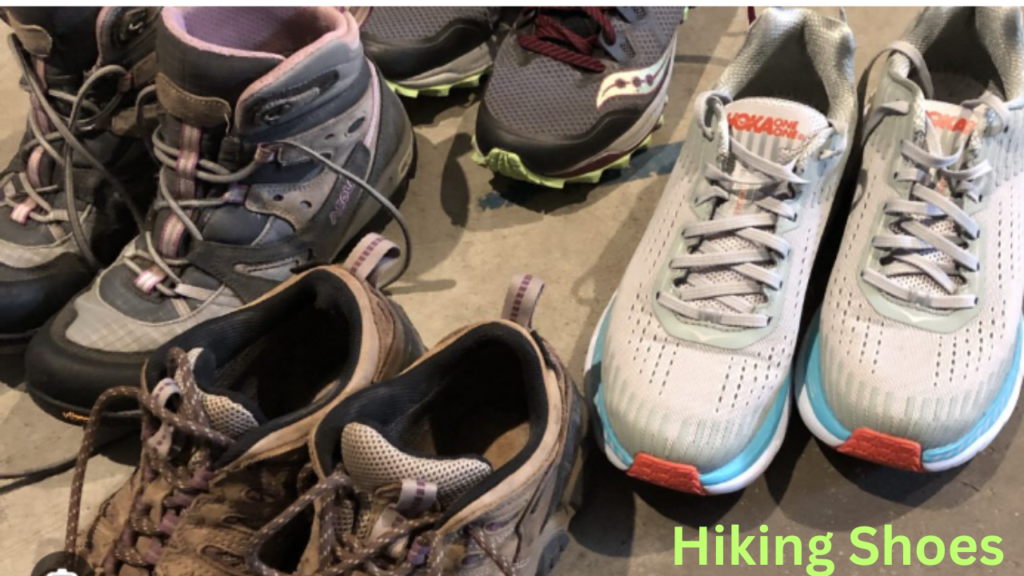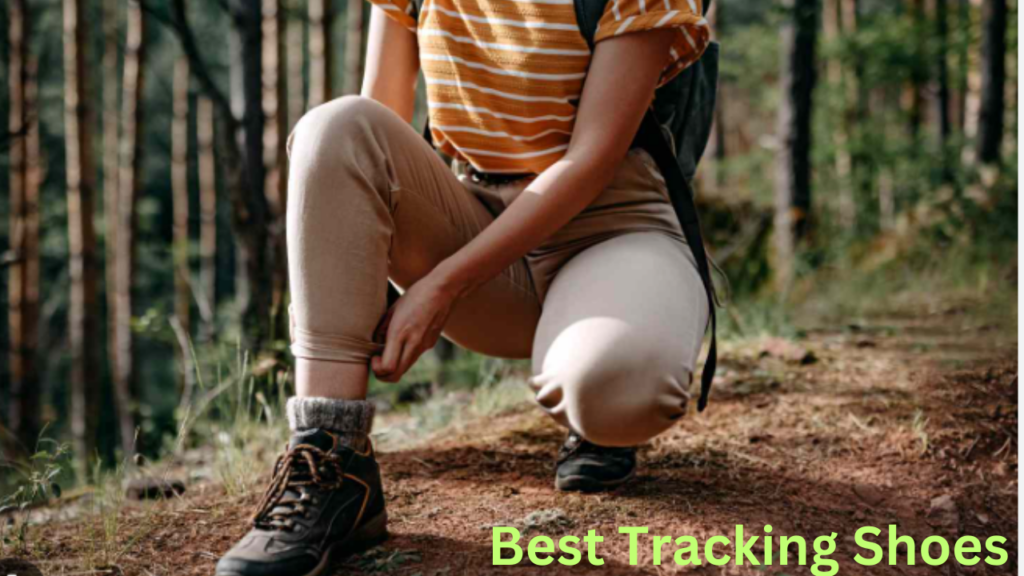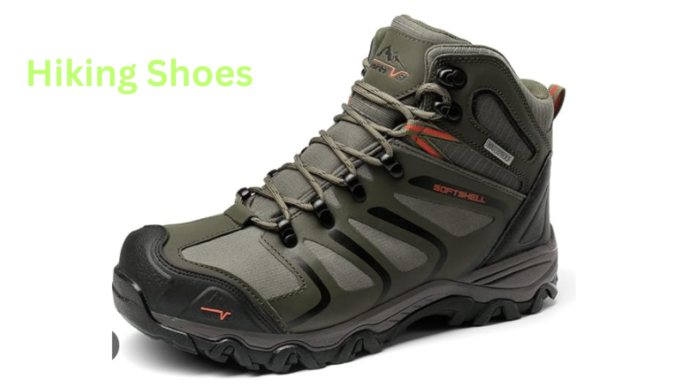Hiking shoes are specialized footwear designed for outdoor activities such as hiking and trekking. They offer a number of features to suit the demands of hiking: Support: They support your feet and ankles to help prevent injuries on uneven terrain.
Traction: The soles are designed to provide good grip on a variety of surfaces, including mud, rocks, and loose gravel. Durability: They are made of durable materials to withstand tough conditions and prolonged use.
Protection: Many hiking shoes have features such as reinforced toe caps and padded collars to protect your feet from rocks, roots, and other obstacles.
Comfort: They are designed to remain comfortable for long periods of time, with plenty of cushioning and good arch support.

Water resistance: Many hiking shoes are water-resistant or waterproof to keep your feet dry in wet conditions.
Breathability: They often include breathable materials to help keep your feet cool and reduce moisture build-up. Hiking boots come in a variety of styles, including low-cut, mid-cut, and high-cut designs, depending on the level of support and protection you need for your ankle.
What’s special about hiking shoes?
Hiking shoes are designed with special features that make them suitable for outdoor activities and rugged terrain.
Here’s what makes them special: Improved traction: Soles often have aggressive treads and patterns that provide better grip on uneven, slippery, or rocky surfaces. This helps prevent slips and falls.
Durable construction: They’re made of high-quality, durable materials that can withstand tough conditions, such as abrasion-resistant fabrics and sturdy outsoles.
Support and stability: Hiking shoes provide better ankle support and stability than regular shoes. They often have reinforced areas around the ankle and foot to help prevent injuries and provide support on uneven ground.
Protection: Features like toe caps and heel counters protect your feet from rocks, roots, and other obstacles. This can help prevent bruises and injuries.
Water resistance: Many hiking shoes come with a water-resistant or waterproof membrane (such as Gore-Tex) that keeps your feet dry in wet conditions. This is important for maintaining comfort and preventing blisters.
Breathability: Hiking shoes are designed with breathable materials to keep your feet cool and dry, reducing the risk of blisters and fungal infections.
Comfort: They usually include cushioning and shock absorption to reduce the impact on your feet and joints while hiking. This helps manage fatigue and discomfort.
Fit and design: Hiking shoes often have a design that takes into account different foot shapes and sizes, with adjustable laces and secure closures to ensure a comfortable fit.
These features combine to provide a safer, more comfortable, and more enjoyable hiking experience.
What shoes are good for hiking?
Choosing the right hiking shoes depends on the type of hiking you plan to do and your personal preferences. Here are some popular options to consider:
- Hiking Boots
Best for: Long hikes, rugged terrain, and variable weather conditions.
Features: Offer excellent ankle support, durability, and protection. Often waterproof and insulated.
Examples: Salomon Quest 4D 3 GTX, Merrell Moab 2 Mid Waterproof.
- Hiking Shoes
Best for: Day hikes, mild trails, and warm weather.
Features: Lighter and more flexible than boots, with good traction and moderate ankle support.
Examples: Merrell Moab 2 Ventilator, Columbia Redmond Waterproof.
- Trail Runners
Best for: Fast-paced hiking, trail running, and well-maintained trails.
Features: Lightweight, good cushioning and breathability, but less ankle support and protection.
Examples: Salomon Sense Ride 4, Brooks Cascadia 17.
- Approach Shoes
Best for: Hiking with climbing or scrambling.
Features: Hiking shoes with sticky rubber soles offer a balance of comfort and climbing shoe grip.
Examples: La Sportiva TX4, Scarpa Drago. - Waterproof Shoes
Best for: Wet conditions, muddy trails and rainy weather.
Features: Waterproof membranes (such as Gore-Tex) keep your feet dry and allow for breathability.
Examples: Keen Targhee III Waterproof, Hoka One One Speedgoat GTX.
Considerations:
Fit: Ensure a snug but comfortable fit with enough room for your toes.
Terrain: Choose shoes based on the terrain you’ll encounter (rocky, muddy, etc.) Weather: Consider waterproof options for wet conditions and breathable options for dry and warm conditions.
Weight: Lighter shoes are more comfortable for hiking, but may offer less support.
It’s always a good idea to test out different styles and brands to find the best fit and comfort for your specific needs.
What is the purpose of hiking?
Hiking serves a variety of purposes, depending on individual goals and interests. Here are some common reasons why people go hiking:
1. Physical exercise: Hiking is a great way to get cardiovascular exercise, build strength, and improve overall fitness. It involves walking on varied terrain, which can increase stamina and muscle tone.
2.Mental relaxation: Many people go hiking to escape the stress of daily life. The natural environment can have a calming effect, reducing anxiety and improving mental health.
3.Connection to nature: Hiking gives individuals the opportunity to experience and appreciate natural landscapes, observe wildlife, and connect with the outside world. It is an opportunity to immerse oneself in nature.
4.Adventure and exploration: Hiking can be a type of adventure, offering the opportunity to explore new trails, discover hidden places, and experience different environments.
5.Social interaction: Hiking can be a social activity, whether it’s going on a group hike with friends, family, or joining a hiking club. It’s a way to connect with others while enjoying the outdoor world.
6.Personal challenge: For some people, hiking is a way to challenge themselves physically and mentally. Completing a difficult hike or reaching a summit can be a gratifying accomplishment.
7.Recreation: Hiking is a recreational activity that can be enjoyed by people of all ages and skill levels. It can be a fun and enjoyable way to spend time outdoors.
8.Educational opportunity: Hiking can also be educational, offering a chance to learn about local flora and fauna, geology, and environmental conservation.
Overall, hiking offers a variety of benefits and experiences, making it a versatile activity for people with different interests and goals.
What material is best for hiking shoes?
The best material for hiking shoes depends on your specific needs, but here are some commonly used materials and their benefits:
1. Leather
Full-grain leather:
Benefits: Very durable, offers great protection, and can be waterproof with the proper treatment. It molds to the shape of your foot over time, providing a custom fit.
Cons: Can be less breathable and heavier. Requires maintenance to keep waterproof.
Split-grain leather:
Benefits: Lighter and more flexible than full-grain leather. Often used in combination with synthetic materials.
Cons: Less durable and less waterproof than full-grain leather.
2. Synthetic materials
Nylon and mesh:
Benefits: Lightweight and highly breathable. Often used in trail shoes and lightweight hiking shoes for warm conditions.
Cons: Generally less durable and less protective than leather. May be less effective at keeping water out.
Synthetic leather:
Advantages: Often used in conjunction with mesh for a balance of durability and breathability. Generally lighter and more affordable than genuine leather.
Disadvantages: May not be as durable or breathable as natural leather.
3. Waterproof membrane
Gore-Tex (or similar):
Advantages: Provides excellent water resistance while allowing breathing. Keeps feet dry in wet conditions.
Disadvantages: Can be more expensive than non-waterproof options and may slightly reduce breathability.
4. Rubber
Outsole:
Advantages: Essential for providing traction and durability. Rubber outsoles with deep tread provide good grip on a variety of surfaces.
Disadvantages: Can add weight to the shoe.
5. Cushioning Materials
EVA (Ethylene Vinyl Acetate) Foam:
Advantages: Commonly used in midsoles for cushioning and shock absorption. Lightweight and flexible.
Disadvantages: Can compress over time, reducing cushioning effectiveness.
PU (Polyurethane) Foam:
Advantages: More durable and supportive than EVA. Provides better cushioning over a long period of time.
Disadvantages: Heavier and more expensive than EVA.
Material selection based on conditions:
For cold and wet conditions: Full-grain leather with a waterproof membrane (such as Gore-Tex) provides durability and protection.
For warm conditions: Mesh synthetic materials are suitable for breathability.
For rough terrain: Materials that provide good support and durability, such as a combination of leather and synthetic materials, are beneficial.
Choosing the right combination of materials can ensure that your hiking boots meet your specific needs for comfort, protection, and performance.
What is the Speciality of hiking shoes?
The specialty of hiking shoes lies in their design and features, which are crafted to enhance performance, comfort, and safety in a variety of terrains. Here’s a closer look at what makes hiking shoes special:

1. Improved Traction
Features: Aggressive tread pattern and high-grip rubber outsole.
Features: Provides better grip on slippery, uneven, and rocky surfaces, reducing the risk of slips and falls.
2. Durability
Features: Robust construction with durable materials like leather, synthetic fabric, and strong stitching.
Features: Able to withstand the wear and tear of rugged terrain, rocks, and obstacles, ensuring long-term use.
3. Support and Stability
Features: Midsole cushioning, arch support, and ankle protection.
Features: Provides stability and reduces the risk of injury by supporting the foot and ankle, especially on uneven or challenging terrains.
4. Protection
Features: Strong toe cap, heel counter, and durable upper.
Feature: Protects feet from rocks, roots, and other hazards, providing extra protection and reducing the chance of injuries.
5. Water Resistance and Waterproofness
Feature: Waterproof membrane such as Gore-Tex or water-repellent treatment.
Feature: Keeps feet dry in wet conditions, preventing discomfort and potential blisters.
6. Breathability
Feature: Mesh panels and moisture-wicking lining.
Feature: Allows air circulation, helps keep feet cool and dry, and reduces the risk of blisters and fungal infections.
7. Comfort and Fit
Feature: Customizable lacing system, cushioned insole, and ergonomic design.
Feature: Provides a comfortable fit that reduces foot fatigue and enhances the overall hiking experience while accommodating different foot shapes and sizes.
8. Flexibility and Weight
Feature: Lightweight materials and flexible design.
Feature: Reduces the overall weight of the shoe, making it easier to hike long distances while maintaining the necessary support and protection.
9. Versatility
Feature: Design variations, including low-cut, mid-cut, and high-cut options.
Feature: Allows hikers to choose shoes based on their specific needs, such as ankle support for rough trails or lightweight shoes for fast-paced hikes.
These special features collectively make hiking shoes well-suited to the demands of outdoor adventures, providing protection, comfort, and performance in a variety of conditions.
FAQs
Here are some frequently asked questions (FAQs) about hiking shoes:
1. What are the main differences between hiking boots and hiking shoes?
- Hiking Boots: Typically offer more ankle support and protection, are sturdier, and are better suited for rough, uneven terrain and backpacking.
- Hiking Shoes: Usually lighter, more flexible, and offer less ankle support. Ideal for day hikes, lighter trails, and warmer weather.
2. How do I know if hiking shoes fit properly?
- Fit: Ensure there is about a thumb’s width of space between your longest toe and the end of the shoe. The shoe should fit snugly around the heel and arch without being too tight.
- Comfort: Walk around in the shoes to check for any pressure points or discomfort. Make sure there is enough room for your toes to move.
3. How do I choose the right hiking shoe for my needs?
- Terrain: Choose shoes based on the type of terrain you’ll be hiking. For rugged trails, opt for boots with more support. For well-maintained trails, shoes or trail runners may be sufficient.
- Weather: Consider waterproof or water-resistant shoes for wet conditions. Breathable shoes are better for hot weather.
- Activity Level: For long hikes or backpacking, prioritize support and durability. For short, casual hikes, comfort and breathability might be more important.
4. How often should I replace my hiking shoes?
- Wear and Tear: Replace them when you notice significant wear on the soles, reduced cushioning, or when they no longer provide adequate support. Typically, hiking shoes need replacement every 500 to 800 miles or 1-2 years, depending on use.
5. Can I use regular sneakers for hiking?
- Not Ideal: Regular sneakers often lack the necessary support, traction, and durability required for hiking. They may not provide the protection or grip needed on uneven or rocky terrain.
6. How do I care for and maintain my hiking shoes?
- Cleaning: Remove dirt and mud after each hike. Clean with a brush and mild soap, and rinse thoroughly. Let them air dry away from direct heat.
- Waterproofing: Apply appropriate waterproofing treatments if necessary. Follow manufacturer instructions for reapplication.
- Storage: Store in a cool, dry place and avoid prolonged exposure to direct sunlight.
7. Are hiking shoes waterproof?
- Varies by Model: Many hiking shoes feature waterproof membranes like Gore-Tex, but not all do. Check the product specifications if waterproofing is important for your hiking conditions.
8. Can I use hiking shoes for other activities?
- Versatility: While hiking shoes are specifically designed for outdoor activities, they can often be used for other activities like casual walking or light trail running. However, they may not be suitable for more specialized sports or activities.
9. How can I prevent blisters while hiking?
- Proper Fit: Ensure your shoes fit well and are broken in before long hikes.
- Socks: Wear moisture-wicking, well-fitting socks. Consider double-layer socks or blister prevention products for added protection.
- Break-in Period: Gradually break in your shoes by wearing them on shorter hikes or walks before tackling more challenging trails.
10. How can I improve the longevity of my hiking shoes?
- Regular Cleaning: Keep them clean and free of debris.
- Proper Storage: Store in a dry, cool place.
- Rotation: If possible, rotate between different pairs to reduce wear on any single pair.



[…] Introduction Fashion of ladies shoes […]